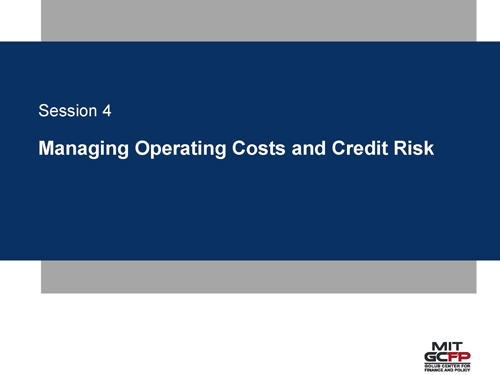Extending credit involves more than getting money out the door in a timely manner. There are widely used techniques and tools for managing credit portfolios efficiently and prudently, and also for measuring program effectiveness. In this session, focus is on the the information necessary for managing performance including the functions associated with extending credit, the costs, the range of choices in performing the functions and the benchmarking of performance. The session is not about Information Technology, but rather how to think about the dynamics of credit-related activities. From the standpoint of the agency budget, such activities are generally funded out of the administrative budget. Session also includes an overview of methods for identifying, assessing and managing credit risk. Finally, this session addresses the metrics that can be used to identify program impact and effectiveness. Together such metrics provide a general basis for performing program cost-benefit analysis.
Operating Cost
There are seven basic functions in the extension of credit: Marketing, origination, underwriting, closing, servicing, monitoring and exit. This session explores:
- Importance and costs of each function Unit cost analysis
- The benefits delegating, outsourcing or sharing the functions
- Technological advances Reducing operating costs through limiting volume and asset sales
Credit Losses
In order to assess risk in a portfolio, program manager relies on a well-defined set of definitions, risk assessment tools and reporting protocols.
- What sort of credit risk are we taking?
- Key problem: the loss curve
- The weak links in the lending process
- Credit scoring
- Definitions: delinquency, modificaton, default, recovery and other key categories
- Rating the loans and reserving percentages
- The concept of the credit audit
Performance Measurement and Evaluation
Key metrics in portfolio management:
- Internal performance measures
- External performance measurement: comparative analysis with the private sector
Interactive
- How many credit functions do we wish to keep in-house and what is the cost-benefit?
- Going from a flawed private sector solution to a federal direct lending solution. The trade-off between operating costs (and practices) and mission objectives coupled with the difficulty of defining delinquency and default.
Lecture Slides
Session 4 Slides: Managing Operating Costs and Credit Risk (PDF)
Charts
Chart 4.1: The Seven Basic Functions for Extending Credit
Chart 4.2: Claculating Operating Costs by Function
Chart 4.3: The Unit Cost Analysis
Chart 4.4: Delegating, Outsourcing, and Sharing
Chart 4.5: Lowering Costs Through Techology Upgrades
Chart 4.6: What Kind of Risk Are we Supposed to be Preparing For?
Chart 4.7: Key Problem: The Loss Curve
Chart 4.8: Credit Scoring
Chart 4.9: Standard Definitions
Chart 4.10: Examples of Rating a Loan and Allocating Losses
Chart 4.11: Credit Audit
Chart 4.12: Key Operating Data Points
Chart 4.13: Key Credit Risk Data Points
Chart 4.14: Conversion Application for Comparative Analysis: From Credit Reform Calculations to Standard Institutional Reporting
Chart Files: Charts for Session 4 (XLSX); Charts for Session 4 (PDF)

